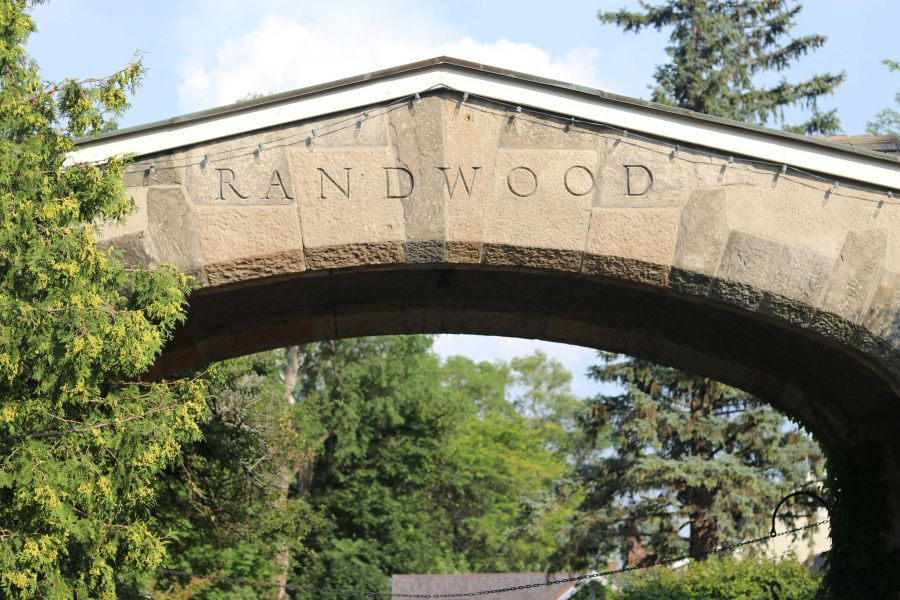This story is one in a series about the history of the Rand Estate, about 35 acres of land lying behind the stone wall on John and Charlotte streets, along the Upper Canada Heritage Trail and whose eastern boundary is a hedge between the properties at 176 and 210 John St.
Elizabeth Masson
Special to The Lake Report
The home on John Street owned by the Dickson and Lansing families, known as Woodlawn, and 19 acres of land were sold in October 1910 for $10,000.
The property’s new owner, George F. Rand, renamed it Randwood.
George Franklin Rand was born in 1867 in Niagara County, New York. At age 16, he began working as an assistant cashier at a bank in North Tonawanda and by 21, he was its president. He married that year and eventually had four children.
Ten years later, Rand’s selection as president of the Columbia State Bank in Buffalo took the family there. Through numerous bank mergers, Rand became president of the Marine Trust Co., one of the strongest financial institutions in the United States at that point in time.
George Rand I expanded the house, adding porches to the front and western side as well as a solarium to the east. The mansard roof over the tower was replaced by an open belvedere, more in keeping with the Edwardian changes made elsewhere. Inside, the dining room was extended and decorated with substantial Doric columns.
In April 1919, Rand acquired the house known as Rowanwood to the west of Randwood and 12 acres of land along Charlotte Street. This area had been divided off from the main Dickson property in the 1860s. He had the house demolished and declared he would turn his estate into one of the showplaces of Canada.
The best-known feature of the Rand Estate, its wall, was probably started in 1919. The foreman of the crew was William Elliott, a trained stonemason from Ireland, and his son and grandson were among the workers. Many descendants of the Elliott family still live in town today.
The wall along John Street is made of concrete supported by brick pillars with a wrought-iron gate in front of Randwood (the house) and a wooden one in front of the white house next door.
Then as the wall rounds the corner to Charlotte Street, its appearance changes. This portion consists of large stones embedded in a concrete base.
There are two curious features which have been placed in this part of the wall. One is a large curling stone and the other a Board of Ordnance stone – one of the markers placed in 1823 to note the boundaries of Niagara's military reserve.
When the wall reaches the former Michigan Central Railroad tracks (now part of the Upper Canada Heritage Trail), it turns and proceeds to the eastern edge of the estate. Unfortunately, this part of the wall has not been as well maintained as the other sections.
Not far from the end, there is a wrought-iron gate through which one can see a dilapidated structure. This served as a shelter when that spot was an unofficial stop on the railroad line.
Not only did Rand family members board the train there but it was also used to transport dairy products after part of the estate was incorporated as Randwood Farms in 1929.
Several other structures were built in this same time period. The wall on Charlotte Street is interrupted by two small buildings, which served as groundskeepers’ homes under the Rands. A large cement arch links them and on it is inscribed the name “Randwood.”
Just behind the groundskeepers’ cottages and slightly closer to the rail line, stables and a small milkhouse (present address: 9 Weatherstone Court) were built. Their style has been termed “eclectic,” combining Romanesque, Queen Anne, Tudor and Colonial Revival styles.
The stables is a long building composed of stucco with a small tower at one end and a very large one at the other; the latter was once the silo. The diamond-shaped window panes are edged with wood.
Before George Rand I could see his many plans for the Rand Estate completed, tragedy intervened. In December 1919, while on a business trip to France, he was taken to visit the battlefield of Verdun.
There, he was so moved by the bravery of the French soldiers who had been killed in the “Trench of Bayonets” that he called upon Premier Georges Clemenceau and offered $50,000 to build a monument to them.
The Trench of Bayonets was created in June 1916. The French 137th Infantry Regiment, positioned in a forward area of the Verdun battlefield, was nearly totally annihilated one day after heavy German shelling.
Months later, an army chaplain visiting the battlefield found a long row of bayonets protruding from the ground and underneath each was a dead soldier standing in place; it is thought they were buried alive by the shelling.
After making his pledge to Clemenceau, Rand embarked on his first plane trip, hoping to get to Southampton in time to catch a boat that would get him home in time to spend Christmas with his children.
Unfortunately, the weather was bad, the plane crashed, and both Rand and the pilot were killed. Now the four Rand children were orphans, their mother having previously died.
George Rand II, the oldest of the Rand children, became guardian for the younger who were still minors. And as his father had promised, $50,000 was given to build the Trench of Bayonets monument, which was dedicated on Dec. 8, 1920.
* Elizabeth (Betsy) Masson has been a research volunteer at the Niagara-on-the-lake Museum for more than 15 years.










